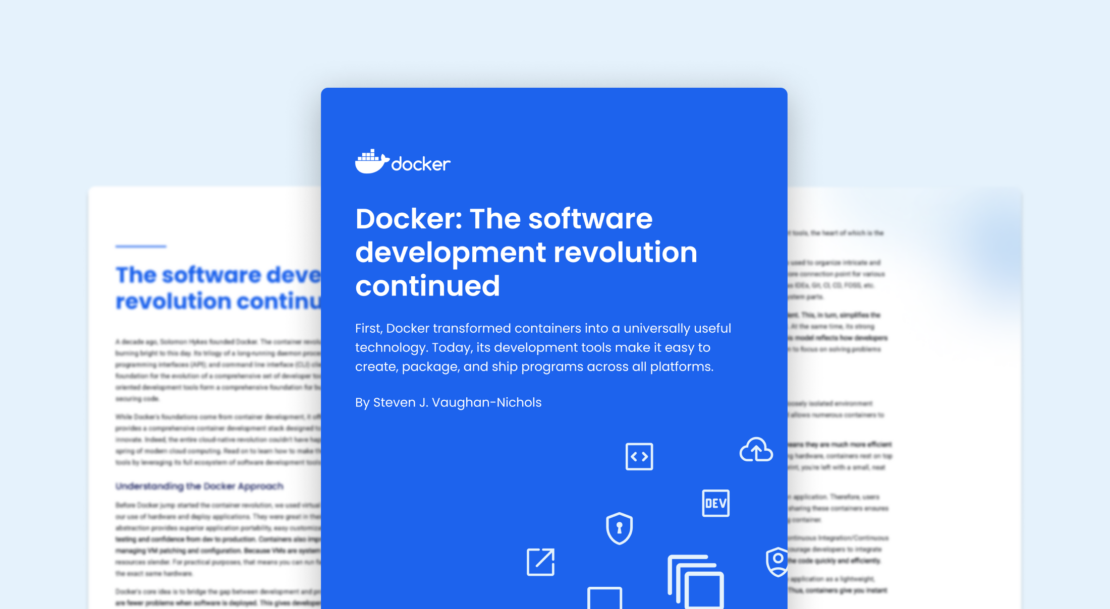More than a decade ago, Docker ushered in the era of containers by making it easy for developers to build, ship, and run applications anywhere. Before Docker, deploying and managing applications was a complex and time-consuming process. Developers had to worry about the compatibility of their applications with the underlying infrastructure, and they had to install and manage all of the necessary dependencies manually. But Docker changed all of that.
Since then, Docker’s suite of development tools, services, trusted content, and automations has vastly expanded. When the Docker suite is used, Docker transforms how businesses accelerate time-to-market, how developers work securely, how teams collaborate, and how software is delivered.
What is included in Docker’s suite, and how can Docker help you accomplish your business outcomes? Read on to find out!

The Docker suite of tools
We know there’s no silver bullet to address your development challenges. But, with Docker’s suite of development tools, services, trusted content, and automations, you can get there faster and identify gaps in your toolkit. Docker was built to be used with different developer tools, and Docker integrations are available for the most popular developer tools on the market, including security, IDEs, and deployment solutions.
Every Docker user gets access to three tools from the start:
- Docker Hub — The world’s largest container repository. Docker Hub lets admins manage their Docker Desktop instances (thus managing developer access to features) and developers can quickly and easily access approved, corporate content, including Docker’s Trusted Open Source Content.
- Docker Desktop — Your access point to an entire environment to develop containers locally. Docker Desktop does all of the heavy lifting when it comes to container setup and maintenance. Your teams will efficiently collaborate, smoothly connect to container libraries and your preferred cloud ISP, and easily view usage data. Docker Desktop includes the developer-loved tools you likely already associate with Docker: Docker Engine, the Docker CLI client, Docker Compose, Docker Content Trust, Kubernetes, and Credential Helper.
- Docker Scout — A developer tool for securing the supply chain, ensuring that containers are built reliably and securely from the start. Docker Scout indexes container images, providing a high-level view of security information so dev teams have contextual and actionable insights to make decisions. With Docker Scout, teams are armed with remediation recommendations, policy evaluation, and trusted artifacts.
How does Docker drive business outcomes?
Now let’s look at three key ways Docker’s suite drives business outcomes.
1. Accelerate time-to-market
At its core, Docker’s suite of tools makes it fast and simple for developers to deliver secure applications. Docker automates many of the manual tasks involved in developing and deploying applications, such as building and testing images, deploying containers to production, and managing containerized applications. This automation makes it easier than ever to get containers up and running quickly and onboard new users efficiently.
Docker also integrates with the most popular developer tools available, so there is a seamless transition to work Docker into existing workflows. All of this frees up developers to focus on writing code and delivering new features to their users faster.
Businesses using Docker have seen a 65% reduction in time to develop software, a 13x increase in release frequency, and 99% faster time from commit to deploy.
2. Enhance security and compliance
The ever-evolving security landscape puts a huge strain on business operations. We know highly regulated industries face strict security and compliance requirements, so Docker empowers developers to be secure from the start of a project’s kick-off. Developers are empowered to work security into their applications at the earliest stages of development rather than waiting until deployment. They can do this by leveraging Docker capabilities like image indexing, remediation recommendations, secrets management, and network isolation.
Docker also lets you customize the level of control and guardrails based on organizational needs and regulatory requirements. For example, organizations can use Docker to implement security policies such as least privilege and role-based access control.
3. Reduce costs; optimize existing tools
As mentioned earlier, Docker integrates with many existing developer tools, so teams don’t need to learn a new tool or workflow when adding Docker to their stack. Additionally, Docker Extensions let developers bring the tools they already use and love into the environment they use every day without adding more complexity to their workflows. Developers can customize Docker to meet their specific needs without having to write any code. This saves your business time and money, because teams don’t have to develop and maintain their own custom tools.
Teams using the Docker suite can take advantage of the scalability and reliability of the cloud without having to invest in their own infrastructure. This means organizations also save money on hardware and software costs.
Conclusion
Docker’s suite of development tools, services, trusted content, and automations has ushered in a new era of containerization, making containers mainstream and a requirement for businesses that want to see positive business outcomes. There’s a reason Docker has consistently been ranked the #1 most-loved development tool. Docker is synonymous with outstanding container technologies, making it easier than ever for developers to build, ship, and run applications anywhere.
Looking for more information on Docker’s suite of dev tools? Download our white paper to learn more.
Learn more
- Read Docker: The software development revolution continued.
- Get the latest release of Docker Desktop.
- Have questions? The Docker community is here to help.
- New to Docker? Get started.
